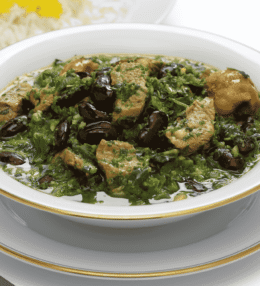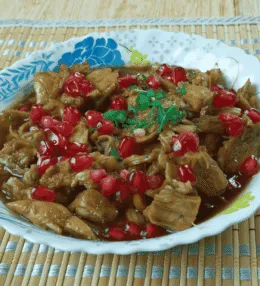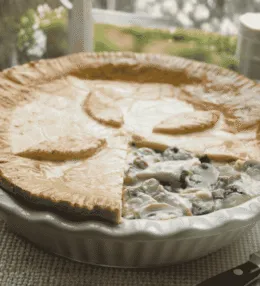
- View
Chelo is classic Persian steamed rice cooked with care until every grain is separate, light and fragrant. It often arrives at the table beside grilled meat, stew or kebab, acting as quiet balance to richer flavours. In Iranian cuisine, chelo is not just a side. It is treated with respect, almost ceremonial.
What makes chelo unforgettable is tahdig. Tahdig is the golden crust that forms at the bottom of the pot. It shatters when you bite into it and brings gentle toastiness that plays against the delicate steamed rice above. Many Iranians grow up competing over tahdig at the table.
Chelo is often finished with a knob of butter and sometimes a pinch of saffron water poured over, so the top of the rice carries a warm yellow tint and soft perfume. That touch of saffron is small but deliberate. It hints at depth, without smothering the natural flavour of the rice.
What Is Chelo?
Chelo is long grain white rice, traditionally basmati, that is soaked, parboiled, then steamed until fluffy. The aim is perfection in texture. Each grain should stay long and slender, never sticky, never heavy, and never mushy. Good chelo almost falls apart like silk when you lift it with a fork.
The method matters. The rice is first rinsed several times to wash out excess starch. It is then boiled until almost tender, drained, then gently steamed in a covered pot. The pot is often lined with oil or butter, sometimes with thin lavash bread or sliced potato to encourage that prized tahdig.
Chelo is often served domed on a platter, with streaks of saffron rice spooned on top for colour and aroma. In a Persian meal, you might see chelo alongside chelo kabab, or next to khoresh, which is a slow cooked stew. The rice supports and steadies whatever sits beside it.
Ingredients and Taste
Good basmati rice. Salted water. Oil or butter. Optional saffron. That is nearly it. Some cooks add yoghurt to the base layer to enrich the tahdig, or use slices of potato or flatbread at the bottom of the pan so that the crust forms in neat, golden sheets.
Despite its short ingredient list, chelo tastes layered. The steamed rice on top is delicate and faintly buttery. It carries light salt and gentle sweetness from the grain itself. The saffron stained portion adds floral warmth and a slight savoury bitterness that lingers. It perfumes rather than pushes.
Then there is tahdig. Tahdig tastes toasted, nutty and caramel edged. You hear the crunch when it breaks. Eaten with the tender inner rice, it gives contrast that keeps each mouthful interesting. This play of textures is part of why chelo holds such a loyal place on the Iranian table.
Chelo also teaches patience. Timing affects everything. Undercook it and the centre stays chalky. Steam it too hard and the base burns harshly instead of turning crisp and clean. Great chelo is not rushed. It shows quiet control in heat, water, steam and rest.
A Taste of History
Although you sometimes see chelo mentioned loosely as steamed Persian rice, that wording is not casual. It is firmly rooted in Iranian food culture. Rice cookery developed over centuries in Iran, shaped by trade routes, access to saffron, and the value placed on shared meals.
The style of steaming rice until long grained and fluffy became closely linked with formal Persian dining. By the Qajar era in the nineteenth century, chelo served with kebab was considered a national pride dish in Tehran, and later spread widely in restaurants, where it became an expected pairing.
Tahdig itself reflects thrift and pleasure together. In essence it began as rice that stuck and crisped at the bottom of the pot. Rather than waste it, people enjoyed it. Over time that crisp layer stopped being an accident and became deliberate. Today, a good tahdig can define whether the cook has done well.
It is worth noting that many regional rice dishes exist in Iran, but chelo stands apart through its insistence on clean flavour, separate grains and elegant presentation. It is not meant to be heavily seasoned within the pot. Season comes later, on the plate, through stew, herbs, pickles and grilled meat.
How to Make Chelo (Steamed Persian Rice)
Chelo is the foundation of Persian cuisine, known for its fluffy texture and the prized golden crust called tahdig. The process involves careful rinsing, parboiling, and steaming to achieve each grain’s perfect separation. Expect a light, aromatic rice that’s both simple and refined, often served with kebabs or stews. See the recipe card at the bottom for printable directions
Ingredients
- 2 cups basmati rice (preferably aged)
- 3 tbsp salt (for soaking and boiling water)
- 3 tbsp unsalted butter or ghee
- 2 tbsp plain yoghurt (for tahdig)
- 2 tbsp vegetable oil
- 1 pinch saffron threads (optional, for garnish)
- 2 tbsp hot water (for saffron infusion)
Cooking Instructions
Step 1: Rinse the rice
Place the basmati rice in a large bowl. Rinse under cold water several times, gently swirling with your fingers until the water runs clear. This step removes excess starch and ensures the rice cooks light and fluffy.
Step 2: Soak the rice
Cover the rinsed rice with cold water, add 1 tablespoon of salt, and let it soak for at least 30 minutes. Soaking helps elongate the grains and improves texture. Drain before cooking.
Step 3: Parboil the rice
Bring a large pot of water to a rolling boil with 2 tablespoons of salt. Add the drained rice and boil for 5 to 6 minutes, stirring gently once or twice to prevent sticking. The rice should be slightly firm in the centre. Drain immediately in a fine colander and rinse briefly with warm water to remove excess salt and stop cooking.
Step 4: Prepare the tahdig layer
In the same pot, melt 1 tablespoon of butter with the vegetable oil over medium heat. Mix the yoghurt with a spoonful of parboiled rice and spread it evenly on the bottom of the pot. This forms the golden crust known as tahdig.
Step 5: Layer the rice
Gently spoon the parboiled rice over the yoghurt mixture, forming a pyramid shape in the pot. Do not press down, as air circulation helps the steaming process.
Step 6: Create steam holes
Using the handle of a wooden spoon, poke several holes through the rice to allow steam to escape evenly. This traditional technique prevents clumping and ensures uniform cooking.
Step 7: Steam the rice
Dot the top of the rice with the remaining butter. Wrap the lid of the pot with a clean tea towel and secure it tightly to catch excess moisture. Place the lid on the pot, reduce heat to low, and steam for 30–40 minutes.
Step 8: Prepare saffron water (optional)
While the rice steams, grind the saffron threads with a pinch of sugar and dissolve in 2 tablespoons of hot water. This aromatic infusion can be drizzled over the rice before serving.
Step 9: Unmould and reveal the tahdig
Once the rice is fully cooked and fluffy, gently spoon out the top rice and set aside. Loosen the bottom crust carefully using a spatula. Turn the tahdig out onto a plate in one golden piece if possible or serve broken into crispy shards.
Step 10: Serve and present
Fluff the rice lightly with a fork. Arrange it on a platter, placing the tahdig on top or alongside. Drizzle with saffron infused water for colour and fragrance. Serve immediately with Persian stews or grilled meats.
Variations and Substitutions
- Rice type: Long grain jasmine rice can be used if basmati is unavailable, though the aroma will differ.
- Fats: Replace butter with ghee for a deeper flavour or use olive oil for a lighter option.
- Tahdig options: Instead of yoghurt, you can use thinly sliced potatoes or lavash bread for different textures.
- Saffron: Turmeric infused water can be used as a mild alternative for colour if saffron is hard to find.
Cooking Tips for Perfect Chelo
- Use aged basmati rice for the most authentic aroma and long, separate grains.
- Always soak the rice to prevent breakage during boiling.
- Avoid lifting the lid during steaming, as it releases essential heat and moisture.
- Let the pot rest for 5 minutes off the heat before unmoulding the tahdig to help it release easily.
- For a richer aroma, add a small cube of butter to the rice just before serving.
How to Store and Reheat
Cooling and Storing
Leftover chelo should cool promptly, as with any cooked rice. Spread it lightly on a wide plate to let steam escape, then place it in an airtight container in the fridge. Try to refrigerate within an hour after cooking. Keeping it sealed prevents the rice drying out and turning brittle.
Tahdig can soften in the fridge. To hold texture, wrap tahdig in paper towel before refrigerating, then place it in a container. The paper helps absorb surface moisture, keeping the crust closer to its original crackle. Store rice and tahdig for no longer than two to three days for safety.
Reheating
To reheat the fluffy portion of the rice, steam is kinder than direct heat. Place the rice in a pan with a splash of water, cover with a tight lid, and warm over low heat until heated through. This brings back softness without making the grains gluey.
Tahdig wants a different approach. Warm it in a dry pan over medium low heat or in the oven on a tray. Dry heat revives the crunch and restores that toasted edge. Avoid the microwave for tahdig, as it often turns rubbery. Serve reheated tahdig quickly, while it is still crisp.
Serving Leftovers
Day old chelo still works beautifully beside stew or kebab. You can also treat it as comfort food. Warm rice, a knob of butter, pinch of salt, squeeze of lemon, maybe a spoon of yoghurt and dried mint. Nothing fancy. Just quiet richness in a bowl.
In Iranian homes, leftover tahdig can become a snack on its own. Pieces are broken off and nibbled with tea, almost like savoury brittle. That small habit says everything about chelo. This is not plain rice. It is memory food, daily food, celebratory food and practical food, all at once.

Chelo (Steamed Persian Rice)
Ingredients
- 2 cups basmati rice preferably aged
- 3 tbsp salt for soaking and boiling water
- 3 tbsp unsalted butter or ghee
- 2 tbsp plain yoghurt for tahdig
- 2 tbsp vegetable oil
- 1 pinch saffron threads optional, for garnish
- 2 tbsp hot water for saffron infusion
Instructions
- Place the basmati rice in a large bowl. Rinse under cold water several times, gently swirling with your fingers until the water runs clear. This step removes excess starch and ensures the rice cooks light and fluffy.
- Cover the rinsed rice with cold water, add 1 tablespoon of salt, and let it soak for at least 30 minutes. Soaking helps elongate the grains and improves texture. Drain before cooking.
- Bring a large pot of water to a rolling boil with 2 tablespoons of salt. Add the drained rice and boil for 5 to 6 minutes, stirring gently once or twice to prevent sticking. The rice should be slightly firm in the centre. Drain immediately in a fine colander and rinse briefly with warm water to remove excess salt and stop cooking.
- In the same pot, melt 1 tablespoon of butter with the vegetable oil over medium heat. Mix the yoghurt with a spoonful of parboiled rice and spread it evenly on the bottom of the pot. This forms the golden crust known as tahdig.
- Gently spoon the parboiled rice over the yoghurt mixture, forming a pyramid shape in the pot. Do not press down, as air circulation helps the steaming process.
- Using the handle of a wooden spoon, poke several holes through the rice to allow steam to escape evenly. This traditional technique prevents clumping and ensures uniform cooking.
- Dot the top of the rice with the remaining butter. Wrap the lid of the pot with a clean tea towel and secure it tightly to catch excess moisture. Place the lid on the pot, reduce heat to low, and steam for 30–40 minutes.
- While the rice steams, grind the saffron threads with a pinch of sugar and dissolve in 2 tablespoons of hot water. This aromatic infusion can be drizzled over the rice before serving.
- Once the rice is fully cooked and fluffy, gently spoon out the top rice and set aside. Loosen the bottom crust carefully using a spatula. Turn the tahdig out onto a plate in one golden piece if possible or serve broken into crispy shards.
- Fluff the rice lightly with a fork. Arrange it on a platter, placing the tahdig on top or alongside. Drizzle with saffron infused water for colour and fragrance. Serve immediately with Persian stews or grilled meats.
Nutrition
You May Also Like







Leave a Review